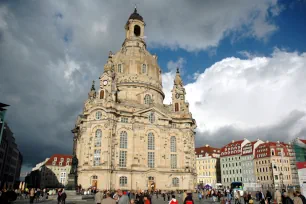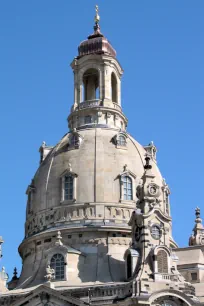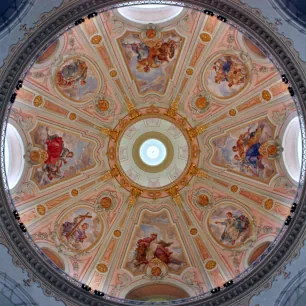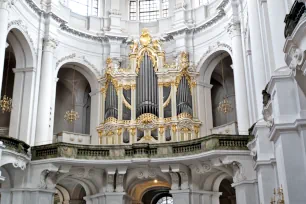For almost fifty years, the Frauenkirche (Church of our Lady) was nothing more than a pile of rubble, the result of a 1945 bombardment. Since its reconstruction in the 1990s, the majestic dome of the Frauenkirche once again dominates the cityscape of Dresden.
Already in the eleventh century a church – the ‘Zu unser lieben Frauen’ – stood at the site of today’s Frauenkirche but by the early eighteenth century the church had become too small for Dresden’s growing population so in 1722 the city’s town council decided to build a new and larger church.
The Building

George Bähr, Dresden’s master carpenter, designed an impressive 95-meter-tall (311 ft.) Baroque church with a stone dome, 23.5 meters (77 ft.) in diameter, on a square ground plan, measuring 45 by 45 meters.
Construction of the Frauenkirche started in 1726 and the church was consecrated just seven years later. The impressive dome, which became known as the ‘stone bell’, was finished in 1738 and consists of a double shell with two casings that make up the inner and outer dome. The magnificent church was completed in 1743. Thanks to its dome – the largest north of the Alps – the church soon became a world-known symbol of the city.

Collapse and Reconstruction
The Frauenkirche seemed to miraculously survive the heavy allied bombings and subsequent fires of February 13, 1945, but on the 15th, after the building’s sandstone had started to cool down, the whole building collapsed.
That same year, the local church started a campaign to gather donations for a reconstruction of the Frauenkirche, but those efforts were halted soon after the end of the war. Forty-five years later, shortly after the fall of the Iron Curtain, Dresden citizens started a new initiative aimed at reconstructing the city’s most iconic building.
The church of Saxony and the city of Dresden soon supported the initiative, and in 1993 preparations for the reconstruction of the Frauenkirche finally started. That year, all the rubble was sorted and put on shelves, so that as much of the original stones could be reused. Those stones – 3643 in total – can be easily identified on the now brand-new looking church: they have a much darker tone than the new sandstones.


Most of the funds for the reconstruction came from donations. The most symbolic is the new replica of the 4.7-meter-tall steeple cross, donated by a group of British donors.
Interior
A circular nave is surrounded by galleries, four stories high. The nave is covered by the inner dome, which is brightly painted and depicts the four virtues and the four evangelists.
The bright white altar, reconstructed in 2000, was originally created in 1733 – 1739 by Johann Christian Feige the Elder and Benjamin Thomae. The Baroque decorations on the altar show the figure of Christ on the Mount of Olives. Above the altar is the church organ, decorated with equally sumptuous Baroque ornamentation.
Viewing platform
A ramp between the inner and outer dome leads to a viewing platform at the top of the dome, just below the cupola. From here, visitors can enjoy magnificent views over the inner city and the Elbe river.

